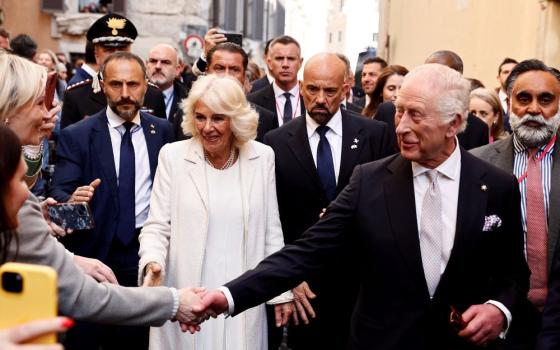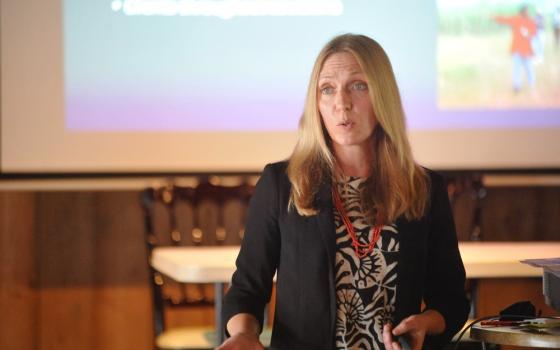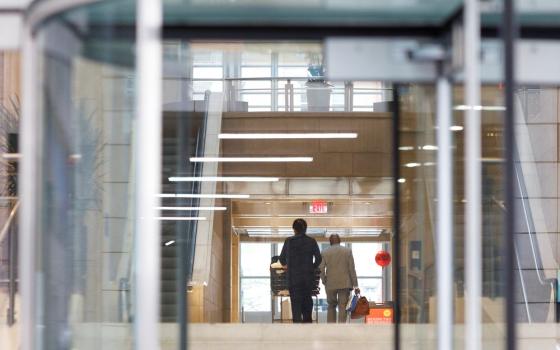
Bishop Ronald Hicks of Joliet, Illinois, is pictured during the 2018 fall general assembly of the U.S. Conference of Catholic Bishops in Baltimore. Sixteen parishes in the Joliet Diocese will be reconfigured into seven parishes, with five churches closing, in order to optimize the diocese's resources for its future and evangelization efforts, Hicks announced Jan. 25. (OSV News/CNS file, Bob Roller)
Sixteen parishes in the Diocese of Joliet, Illinois, will be reconfigured into seven parishes, with five churches closing, in order to optimize the diocese's resources for its future and evangelization, the diocese announced Jan. 25.
The decision impacts parishes in and around the city of Joliet, southwest of Chicago, the diocese's see city and part of its Joliet Deanery, one of eight deaneries, or geographic subdivisions.
"This moment is of great historical significance in that the Joliet Diocese has never undertaken a project of such magnitude," Bishop Ronald Hicks of Joliet said in a Jan. 25 statement on the diocese's website.
"The restructuring of the Joliet Deanery is deliberate, proactive, and anticipatory of the future of the Deanery based on current facts," he said. "It will allow us to refocus on our mission as disciples of Jesus and spread His good news through service to the poor, the homeless, the unborn, the fallen away Catholics, the lost sheep, and so many others who are searching for answers and yearning for the love and peace that only Jesus can provide."
The decision followed a diocesan committee's yearlong process to determine the deanery's future. The committee recommended the changes Dec. 21. Hicks said he accepted the recommendations after prayer, discernment and a Jan. 24 consultation with the diocese's presbyteral council and college of consultors. He announced the changes and issued corresponding decrees Jan. 25.
Advertisement
Hicks, who has led the diocese since September 2020, attributed the decision to changes over the past half-century, including fewer and aging priests, and aging church buildings, as well as lower Mass attendance and "the trend against organized religion."
"As we all are aware, many things have changed in the last 50 to 60 years. We have significantly less vocations to the priesthood, our active priests are aging, and our beautiful churches that were built with labors of love and much financial sacrifice are in need of significant repairs, largely due to prolonged deferred maintenance," he said in the statement.
"In addition, the Church today is not the same Church it was decades ago," he continued. "The trend against organized religion is gaining momentum. Attendance at Sunday Masses is down significantly, and Sunday collections are down proportionately. Reducing the number of parishes will enable us to redirect our limited financial resources to ministry, instead of staffing expenses such as payroll and benefits, and putting temporary and costly band-aids on aging buildings."
As of 2021, the year of the most recent data, the Joliet Diocese had a Catholic population of 520,148, with 117 parishes and seven mission churches. Founded in 1948, the diocese recorded its highest number of parishes — 122 — in 2003 and 2004. In his Jan. 25 announcement, Hicks noted that the diocese had previously closed four parishes in the city of Joliet, in 1982, 1991, 2003 and 2007.
The restructuring includes three groups of parishes, each of which are expected to see parishes "extinguished," or ceasing to exist. Two of those configurations also will see two church buildings closed, with a third configuration involving the closure of one church building.
The affected parishes include St. Anthony, St. Bernard, St. Joseph and St. Mary Magdalene which will all be extinguished and merged into a new parish with worship on the campuses of the former St. Joseph and St. Mary Magdalene. St. Anthony and St. Bernard churches will close.
Nearby, Sacred Heart, St. Paul the Apostle, St. Jude and St. Patrick — the diocese's oldest parish — will merge into a new parish, with worship on the campuses of the former St. Paul the Apostle and St. Patrick. St. Jude and Sacred Heart churches will close.
In Crest Hill, north of Joliet, St. Anne Parish will be assumed into St. Ambrose Parish.
"Reducing the number of parishes will enable us to redirect our limited financial resources to ministry, instead of staffing expenses such as payroll and benefits, and putting temporary and costly band-aids on aging buildings."
— Bishop Ronald Hicks
The reconfiguration left intact the Joliet parishes of Our Lady of Mount Carmel, St. John the Baptist and the Cathedral of St. Raymond Nonnatus in northwest Joliet. St. John the Baptist is currently staffed by Franciscan Friars of the Sacred Heart Province and home to the province's postulancy. The plan notes that when St. John the Baptist is no longer staffed by Franciscans, the parish will be assumed into the nearby St. Raymond, and a decision will be made as to whether to close St. John the Baptist's church.
In addition to the parish restructuring, St. Paul the Apostle Catholic School and St. Jude Catholic School, both in Joliet, will close and be replaced by a new parish school, operating on the campus of St. Paul the Apostle.
"The new school will serve as a model for surrounding schools with added programming and outstanding academics steeped in Catholic teachings," Hicks said in his Jan. 25 statement.
The anticipated June 2024 closure of St. Matthew Parish School in Glendale Heights, 40 miles north of Joliet, is not related to the Joliet Deanery restructuring, Hicks said, but rather due to "significant loss of enrollment over the past five years, a large annual deficit and substantial loss of funds due to the sunset of the Illinois Tax Credit Scholarship."
"Multiple factors were considered in this process, including but not limited to data points on priests, seminarians, parish finances, parish facilities' assessments, sacramental numbers, October Mass counts, and average number of seats occupied at weekend Masses," Hicks said of the overall reconfiguration.
Other considerations included the number and age of priests currently serving and available to serve as pastors; the availability of qualified professionals for parish staff positions; the best use of existing parish facilities; and the costs to staff and maintain parishes, he said.
"At the end of the day, I do not want us to be viewed as a diocese that buried its head in the sand or kicked the can down the road," he said. "Instead, with deep faith in God, we are pruning some of the structural branches, so that our Church can continue to produce great fruit."




